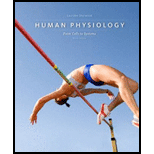
Human Physiology: From Cells to Systems (MindTap Course List)
9th Edition
ISBN: 9781285866932
Author: Lauralee Sherwood
Publisher: Cengage Learning
expand_more
expand_more
format_list_bulleted
Concept explainers
Question
Chapter 1.4, Problem 1CYU
Summary Introduction
To distinguish:
Between the extrinsic and the intrinsic control.
Introduction:
Homeostasis can be defined as a state of equilibrium in which the body's internal environment lies in the normal range. It is important for the body, as any physiological disturbance can interrupt the basic body function and would result in illness. The homeostatic control mechanism is divided into two types, intrinsic and extrinsic.
Expert Solution & Answer
Trending nowThis is a popular solution!

Students have asked these similar questions
(This is a 2-part work, Part 1 is done, only Part 2 is to be worked on at the bottom)Part 1 (Done): Describe the levels of structural hierarchy for the human body, starting with the organismal level and ending with the chemical level. In addition, you should make sure you link each level to the previous level, emphasizing the structural relationships.
The human body is organized into a structural hierarchy that progresses from the macroscopic organismal level down to the microscopic chemical level. Each level builds upon the previous one, creating increasingly complex structures. Below is the hierarchy, from largest to smallest, with explanations linking each level to its predecessor:
1. Organismal Level
The entire living human body.Relationship: All lower levels work together to sustain life at this highest level.
2. Organ System Level
Groups of organs working together to perform major functions.Examples: circulatory, nervous, digestive systems.Relationship: The organismal…
Describe the levels of structural hierarchy for the human body, starting with the organismal level and ending with the chemical level. In addition, you should make sure you link each level to the previous level, emphasizing the structural relationships.
9
S
es
Read the section "Investigating Life: In (Extremely) Cold Blood." Then, drag and drop the terms on the left to complete the concept
map.
Red blood cells
Genes
Icefishes
-have mutated
have colorless
Oxygen
have few
lack
encode
Blood
Cellular
respiration
consists of-
contain
carries
is a
Platelets
White blood
cells
carries
low
amounts
of
Hemoglobin
is necessary for
Plasma
Protein
Reset.
Chapter 1 Solutions
Human Physiology: From Cells to Systems (MindTap Course List)
Ch. 1.1 - Define physiology.Ch. 1.1 - The nutrient-absorbing intestinal cells have a...Ch. 1.2 - Prob. 1CYUCh. 1.2 - Prob. 2CYUCh. 1.2 - Prob. 3CYUCh. 1.3 - Distinguish among external environment, internal...Ch. 1.3 - Prob. 2CYUCh. 1.3 - Prob. 3CYUCh. 1.4 - Prob. 1CYUCh. 1.4 - Prob. 2CYU
Ch. 1.4 - Draw a row diagram showing the relationships among...Ch. 1 - Which of the following activities is not carried...Ch. 1 - Prob. 2RECh. 1 - Which of the following is not a type of connective...Ch. 1 - The term tissue can apply either to one of the...Ch. 1 - Cells in a multicellular organism have specialized...Ch. 1 - Cell specializations are usually a modification or...Ch. 1 - The four primary types of tissue are...Ch. 1 - Prob. 8RECh. 1 - Prob. 9RECh. 1 - _________ controls are inherent to an organ,...Ch. 1 - Prob. 11RECh. 1 - Compare physiology and anatomy.Ch. 1 - Prob. 2UCCh. 1 - Prob. 3UCCh. 1 - Prob. 4UCCh. 1 - What factors must be homeostatically maintained,...Ch. 1 - Prob. 6UCCh. 1 - Prob. 7UCCh. 1 - Prob. 1ACRCh. 1 - Prob. 1TAHLCh. 1 - Prob. 2TAHLCh. 1 - The hormone insulin enhances the transport of...Ch. 1 - Prob. 4TAHLCh. 1 - Prob. 5TAHL
Knowledge Booster
Learn more about
Need a deep-dive on the concept behind this application? Look no further. Learn more about this topic, biology and related others by exploring similar questions and additional content below.Similar questions
- Plating 50 microliters of a sample diluted by a factor of 10-6 produced 91 colonies. What was the originalcell density (CFU/ml) in the sample?arrow_forwardEvery tutor here has got this wrong, don't copy off them.arrow_forwardSuppose that the population from question #1 (data is in table below) is experiencing inbreeding depression (F=.25) (and no longer experiencing natural selection). Calculate the new expected genotype frequencies (f) in this population after one round of inbreeding. Please round to 3 decimal places. Genotype Adh Adh Number of Flies 595 Adh Adh 310 Adhs Adhs 95 Total 1000 fladh Adh- flAdn Adh fAdhs Adharrow_forward
- Which of the following best describes why it is difficult to develop antiviral drugs? Explain why. A. antiviral drugs are very difficult to develop andhave no side effects B. viruses are difficult to target because they usethe host cell’s enzymes and ribosomes tometabolize and replicate C. viruses are too small to be targeted by drugs D. viral infections usually clear up on their ownwith no problemsarrow_forwardThis question has 3 parts (A, B, & C), and is under the subject of Nutrition. Thank you!arrow_forwardThey got this question wrong the 2 previous times I uploaded it here, please make sure it's correvct this time.arrow_forward
- This question has multiple parts (A, B & C), and under the subject of Nutrition. Thank you!arrow_forwardCalculate the CFU/ml of a urine sample if 138 E. coli colonies were counted on a Nutrient Agar Plate when0.5 mls were plated on the NA plate from a 10-9 dilution tube. You must highlight and express your answerin scientific notatioarrow_forwardDon't copy off the other answer if there is anyarrow_forward
arrow_back_ios
SEE MORE QUESTIONS
arrow_forward_ios
Recommended textbooks for you
 Human Physiology: From Cells to Systems (MindTap ...BiologyISBN:9781285866932Author:Lauralee SherwoodPublisher:Cengage Learning
Human Physiology: From Cells to Systems (MindTap ...BiologyISBN:9781285866932Author:Lauralee SherwoodPublisher:Cengage Learning Principles Of Radiographic Imaging: An Art And A ...Health & NutritionISBN:9781337711067Author:Richard R. Carlton, Arlene M. Adler, Vesna BalacPublisher:Cengage Learning
Principles Of Radiographic Imaging: An Art And A ...Health & NutritionISBN:9781337711067Author:Richard R. Carlton, Arlene M. Adler, Vesna BalacPublisher:Cengage Learning

Human Physiology: From Cells to Systems (MindTap ...
Biology
ISBN:9781285866932
Author:Lauralee Sherwood
Publisher:Cengage Learning


Principles Of Radiographic Imaging: An Art And A ...
Health & Nutrition
ISBN:9781337711067
Author:Richard R. Carlton, Arlene M. Adler, Vesna Balac
Publisher:Cengage Learning


